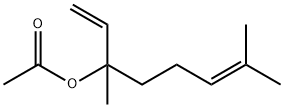A3197712
Decyl acetate , 98% , 112-17-4
Synonym(s):
Capryl acetate
CAS NO.:112-17-4
Empirical Formula: C12H24O2
Molecular Weight: 200.32
MDL number: MFCD00026538
EINECS: 203-942-2
| Pack Size | Price | Stock | Quantity |
| 25ml | RMB36.00 | In Stock |
|
| 100ML | RMB90.40 | In Stock |
|
| 500ML | RMB196.00 | In Stock |
|
| 2.5L | RMB558.40 | In Stock |
|
| others | Enquire |
Update time: 2022-07-08
PRODUCT Properties
| Melting point: | -15.03°C |
| Boiling point: | 126-127 °C20 mm Hg(lit.) |
| Density | 0.863 g/mL at 25 °C(lit.) |
| vapor pressure | 2.48Pa at 25.9℃ |
| refractive index | n |
| FEMA | 2367 | DECYL ACETATE |
| Flash point: | >230 °F |
| storage temp. | Sealed in dry,Room Temperature |
| solubility | Insoluble in water |
| form | clear liquid |
| color | Colorless to Almost colorless |
| Odor | at 100.00 %. waxy clean fresh laundered cloths citrus soapy |
| Odor Type | waxy |
| biological source | synthetic |
| Water Solubility | 2.07mg/L at 20℃ |
| JECFA Number | 132 |
| BRN | 1762123 |
| LogP | 5.6 at 35℃ |
| CAS DataBase Reference | 112-17-4(CAS DataBase Reference) |
| NIST Chemistry Reference | Acetic acid, n-decyl ester(112-17-4) |
| EPA Substance Registry System | Acetic acid, decyl ester (112-17-4) |
Description and Uses
Decyl acetate finds little use in perfume compositions as a modifier for Linalyl acetate and generally as a ‘“fresh’” note in delicate florals (Muguet, etc. ) or in aldehydic top note compositions. It blends excellently with Dodecanal (Aldehyde C-1 2, Laurie). Finds some use in flavour compositions, mainly for imitation Apple, Berry, Honey, Orange, Peach, Plum, etc. and also in Rum flavours. The concentration of Decyl acetate in the functional product amounts usually to traces only.
Safety
| Symbol(GHS) |  GHS09 |
| Signal word | Warning |
| Hazard statements | H410 |
| Precautionary statements | P273-P391-P501 |
| WGK Germany | 2 |
| RTECS | AG5235000 |
| TSCA | Yes |
| HS Code | 2915.39.9000 |
| Toxicity | Both the acute oral LD50 value in rats and the acute dermal LD50 value in rabbits were reported as >5 g/kg(Levenstein, 1974). |




